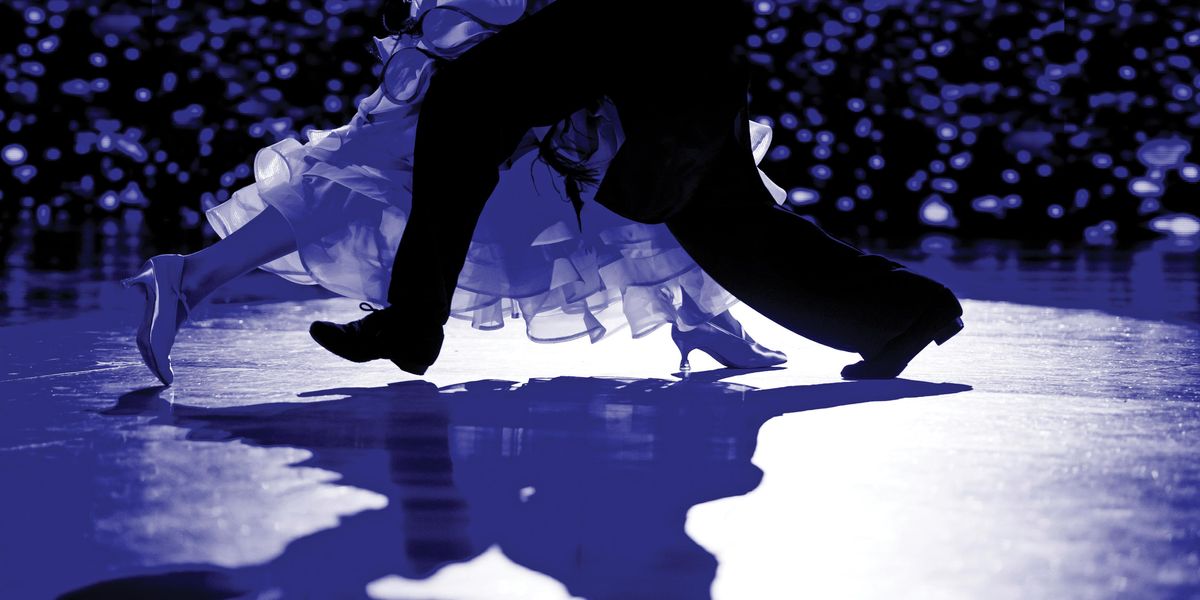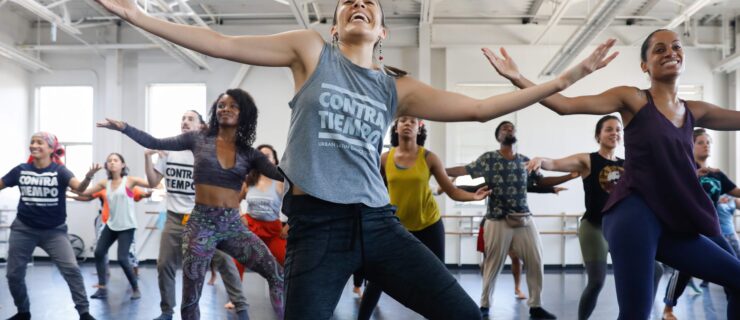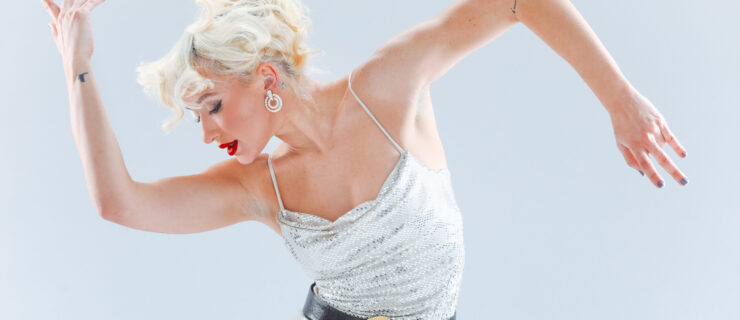How Ballroom Can Improve Your Dancing in Any Style
After 11 years of dancing on world tours, award shows, film and television, Britt Stewart was ready for a new challenge. Fate was on the same page. While in rehearsal for Disneyland’s 60th anniversary, the producers of “Dancing with the Stars” saw her dance and asked her to audition for the “DWTS” Troupe, the group of professional dancers that used to perform on the show as an ensemble.
“Six months later I was on the show without any formal ballroom training,” she says. After immersing herself in the ballroom world, she became a “pro” on the series—paired with celebrities to compete—dazzling audiences with her character-rich choreography, magnetic performance quality and stunning lines.
Diving into ballroom dance has opened doors that Stewart hadn’t previously known were available, and subsequently brought more variety to her dancing and choreography overall. “I mean, what hasn’t ballroom benefited in my career?” Stewart says, noting her expanded musicality, broadened performance opportunities and newly nuanced partner work. She is one of the many dancers who have discovered that adding ballroom to your arsenal can enhance your dancing technically and artistically, mentally and physically.
Ballroom 101
Ballroom doesn’t follow the same training and performance pattern of commercial or concert dance. Most training is done privately with a partner and coaches, and each class generally works on a set piece of choreography. So, for example, you may work on your samba choreography for one rehearsal, and cha-cha for another. Occasionally master teachers will hold group classes with multiple couples/individuals, or dancers may attend classes called “rounds,” in which they perform all their dances with other couples in the room and receive critiques as if it were a competition.
Most ballroom dances are done in a circular, counterclockwise pattern (think ice skating) with the audience surrounding the performers on all sides. In traditional ballroom competitions, dance routines are not typically set to a specific song. Rather, the routines are performed to songs that fit the proper rhythm of the selected style. The exception to this rule is when dancers are asked to perform set choreography numbers at commercial competitions, like NUVO, for example, or on shows like “Dancing with the Stars” or “So You Think You Can Dance.”
Ballroom is also performed in various live productions (many Las Vegas shows incorporate ballroom dance), which are generally set to specific songs. Beyond these, primary performance opportunities for professional ballroom dancers are at ballroom competitions.
Emotional Experience
Trying any new style stimulates the body in new ways. “Dancers are generally very passionate about their genre, which is great, but to prevent tunnel vision that paints you into a corner, it’s important to diversify your training,” says Jo-Anne La Flèche, resident psychologist at the École Supérieure de Ballet du Québec. “Otherwise, you will get too comfortable in automated processes that won’t challenge either your mind or body.”
Exploring a new style can also keep you connected to your inner child. “Dance is often painful,” La Flèche says. “We all need to play.” La Flèche, who herself enjoys training in ballroom dance with her husband, points out that ballroom is particularly suited for play because it was created in a recreational and social setting. “Even if you work hard, ballroom has that particular flavor of fun,” she says. “It’s about getting dressed up and having a ball.”
Stewart felt the emotional release from ballroom dance herself. “As much as I love dance, there have been a couple times in my life where I’ve been burned out,” she says. After finishing a tour with Katy Perry in 2016, ballroom offered a chance to shake things up. “It was so opposite of anything I’d done before, and because of that, it was a challenge that brought me out of my funk,” she says. “It’s been five years, and it’s still new and exciting to me. That chance to never stop learning has really helped me emotionally and mentally.”
Partnering Perks
There is perhaps no greater benefit ballroom can give an artist than partnering skills. “Being able to partner is one of the greatest things you can add to your resumé that will make you an automatic standout for a lot of opportunities,” says NUVO Dance Convention ballroom teacher and former “DWTS” pro Ashly Costa.
Stewart found that the emphasis on proper weight placement, and how that might affect balance, helped her become a better partner in other genres, too. As La Flèche describes it, in ballroom, the weight is shifted forward because dancers present their torsos first, to facilitate walks, whereas in other genres, the weight is more likely to be distributed at the center of the body. Grasping this difference and practicing a new weight placement can clarify old understandings, and hone both approaches.
“In ballroom, if you give even just a little too much weight to your partner, it will put them off-balance,” Stewart says. “Discovering where that balance is helps form a bond between you and your partner, and you become one.”
Contemporary choreographer Lauren Adams, who added ballroom to her dance tool belt when she was 30 years old, found that the structure of leading and following made her a better listener. “When I started, I wanted to dance full-out, and my teachers told me to calm down so I could listen and follow,” she says. “Now, even if I’m choreographing a solo, I am thinking about the feedback I am getting from the space, from the floor and from the people around me.”
La Flèche points out that the communication skills you develop can be useful on and off the dance floor. The extensive amount of time ballroom couples spend together helps them to collaborate effectively, and the strongest couples learn to strengthen both verbal and nonverbal skills.
Pumped-Up Performance
The many styles of Latin dance in particular provide opportunities to embody different moods and characters. “Cha-cha is sassy, samba is the party dance, rumba is sensual with hints of sadness and vulnerability, and paso doble is intense,” Costa says. Each style draws on different emotions, helping dancers learn to channel a range of feelings.
Adams was taken aback by the intensity of ballroom the first time she observed it. The performance quality is “the most full-out,” she says. Today, she finds that many of the dancers she works with who study ballroom develop performance skills from a young age. “That breeds a lot of confidence,” she says.
Improvisation Variety
Watching a sea of dancers improvise at a contemporary audition can often feel like Groundhog Day: The same legs, turns and movement quality bleed into the dancers’ work over and over. Yet those who have ballroom training usually stand out. “They have a skill set that not many others have,” Costa says.
For example, if the music playing is a samba rhythm (like Sia’s “Cheap Thrills” or Ed Sheeran’s “Shape of You”), ballroom dancers can use voltas, cruzados walks, bachatas and botafogos, along with standard pirouettes, battements, leaps and floorwork. Adams says, “I love to see a dancer hear a cha-cha rhythm and start doing cha-cha—they have more available to them in terms of variety.”
That variety often brings dancers back to the core of their art form. “The greatest thing about ballroom is it isn’t about tricks, it’s actual dance steps,” Costa says. Each style of ballroom has specific steps and rhythms associated with it that are canonized in technique books and incorporated into syllabi based on level. These techniques are what make up the meat of dances.
Only after a proper foundation of technique is laid can a few contortions or flips be worked into a routine. “The overuse of tricks in dance is like watching a movie with great special effects but a weak narrative,” Costa says. “Having a grasp of style and movement speaks volumes, and that’s what ballroom provides.”
Ingrained Rhythm
Like tap, ballroom has a heavy emphasis on musicality that can translate organically to other styles. “A trained ballroom dancer knows how to find the rhythm,” Costa says. “They know that a cha-cha beat is counted 2, 3, 4, and 1, and are able to stay in the pocket when they hear it.” In ballroom, you never know what music you will be dancing to—you simply know the beat. Thus, you have to be able to listen and adapt.
Greater Versatility
Today, ballroom styles can be found on Broadway, in Vegas shows and in commercial opportunities. Even more jobs incorporate heels work. “Dancing in heels is a difficult skill,” Costa says. “Ballroom helps dancers know how to wear them and look great. If you don’t understand where your weight should be (hint: on the inside of the ball of your foot), and you haven’t practiced often, you’re gonna struggle.”
Warning: Ego Check
“Ballroom dance is a lot more complicated than it looks,” warns La Flèche. “As a dancer in another genre, you will have to deconstruct many neuromuscular coordinations in your body.” Challenges for classical and commercial dancers include the rapid and complex hand changes; a strict lack of external rotation; dancing in a closed-loop space with circular patterns rather than a proscenium stage with an audience just in front; navigating couples who share the space, but are not dancing set choreography; and, for those dancing the traditionally female role, moving backward while being guided by a partner.
It helps to approach these new skills without ego. Adams suggests, “Just jump in and have some fun!”




